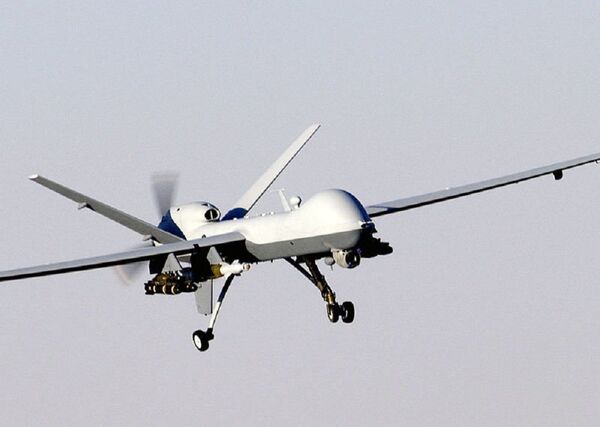Commenting on reports about the US allegedly considering a military operation in the Philippines against Islamist militants controlled by Daesh (ISIS/ISIL), Sputnik contributor Alexander Khrolenko highlighted that the US Air Force would supposedly use combat drones for the strikes, and explained why such move would be disastrous for the country.
"The American-style drone war could lead to unpredictable consequences," the journalist warned, "The unmanned aerial vehicles' (UAVs) strikes usually claim more lives of civilians than the attacks of manned aircraft."
Citing two defense officials, the NBC broadcaster reported Monday that the US Department of Defense was allegedly mulling over a drone operation in the Philippines.
If the plan had been approved, the US armed forces would be authorized to attack militants which pose a threat to US allies, most notably the Philippine Armed Forces, in the region.
Khrolenko recalled that back in May 2017 Rodrigo Duterte, the president of the Philippines, introduced martial law in the Mindanao following fierce clashes between the country's armed forces with Islamic extremists.
While the Philippine security forces continue conducting a ground operation in the region the country's Italian-made SF-260 aircraft are carrying out strikes on terrorists from the air, the journalist wrote.
"Manila needs foreign military assistance, and still this assistance should be commensurate with threats and circumstances," Khrolenko stressed.

"From a tactical point of view, it is easier to control the vast territory of the island state from the air," the journalist elaborated. "However, US combat drones are not always capable of distinguishing militants from civilians. The optoelectronic field of vision does not provide an accurate identification of objects. [Therefore] there is the risk of attacking civilians, cars or houses taken for enemy facilities."
But that's only half the problem.
"Given the high population density with more than 100 million people living in the Philippines, the use of hostages by terrorists and the terrain masking, one could easily predict the inevitable and numerous casualties among ordinary Filipinos, not-involved in terrorist activities," Khrolenko pointed out.
As it has been repeatedly reported the US drone strikes in Yemen, Somali and Libya showed that the technology is still far from perfect.
Furthermore, as Micah Zenko, a Senior Fellow at the Council on Foreign Relations (CFR), highlighted earlier this year in Barack Obama's last year in office the US dropped 26,171 bombs in seven countries.
"In 2016, the United States dropped 3,027 more bombs — and in one more country, Libya — than in 2015. Most (24,287) were dropped in Iraq and Syria," Zenko noted.
To complicate matters even further, not all of these bombs reached their intended targets — many killed civilians on the ground.
Khrolenko referred to the fact that the efficiency of drone strikes still raises questions.
"For example, the MQ-1 Predator hits an average of 17 targets out of a hundred. And for each ten militants affected, there are about 700 dead civilians," he wrote.
"As for the Afghan chronicle of unmanned war, [it was reported that] out of 200 deaths from US air strikes from January 2012 to February 2013, only 35 people were designated as targets, while the others were casual victims. How is that possible?" Khrolenko asked rhetorically.
It appears that Washington's reckless drone war poses a similar threat to the inflicted nations as the much discussed extremist activities, the journalist noted.
What if America's military assistance to Manila turned out to be a "bigger evil" than the terrorists themselves?




